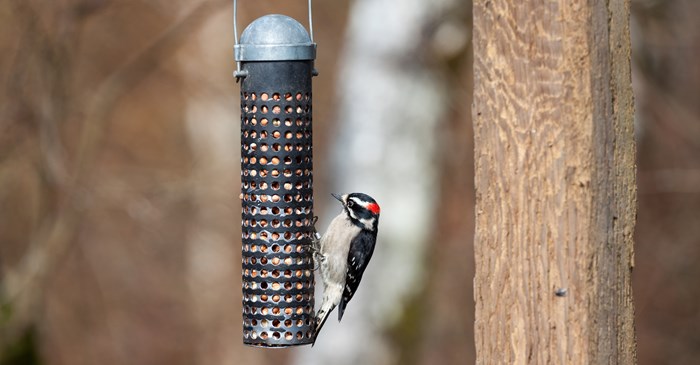The smallest of the North American woodpeckers, the Downy Woodpecker, with its black-and-white checked plumage, can be found pretty much anywhere trees dwell in the U.S. and Canada — except for deserts and the island of Hawaii.
Like most woodpeckers, their preferred food is insects, and in the summer months, you’ll find them clinging to trees and perched on tall weeds, digging around in the bark for bugs and larvae. But in the winter, they forage for berries and seeds, joining flocks of Black-capped Chickadees and White-breasted Nuthatches. You'll also find them alight on your bird feeder and, like their chickadee companions, they are not as easily spooked as other feeder species.
In their hunt for insects, the Downy Woodpecker doesn’t produce that constant tapping sound other woodpeckers make. Not that they don’t hammer. During spring courtship, which can begin as early as February, they will hammer on trees as well as metal objects, such as gutters and chimneys, to stake their territories and re-establish bonds with their mates. As courtship proceeds, males and females will fly between the trees making "slow, fluttering wingbeats that look almost butterfly-like."
To nest, they will excavate a small area from a dead tree, clearing a cavity about 7 inches in diameter that dips down into the body of the tree. Once they've finished their nest cavity, they line the bottom with wood chips and take turns incubating the eggs, raising one brood of 4-5 nestlings a year — though birds in warmer climates may raise two broods.
Sometimes the Downy Woodpecker is mistaken for its near look-alike, the Hairy Woodpecker. To distinguish the two, keep in mind the Downy is smaller and has a shorter bill.
Set out a protein-rich, no-waste mix in a hopper feeder near a tree to attract the Downy Woodpecker to your yard. Lyric Woodpecker Mix features shelled peanuts, sunflower kernels, corn, dried cherries and other sweet and savory nuggets to help them refuel during winter's cold months.
